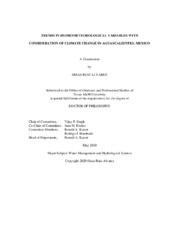| dc.description.abstract | The main goals of this dissertation were to determine the trend of monthly evaporation, study the trend in extreme temperature indices, analyze trends in extreme precipitation indices, and explain the implications of trends in hydrometeorological variables in Aguascalientes’ agriculture. Daily evaporation, daily maximum and minimum temperature, daily precipitation data, and bibliographic references of agricultural statistics and published works on the adaptation of the crop to the environment were used. Sixteen/eleven extreme temperature/precipitation indices were estimated, and their trends were evaluated with the Mann-Kendall test. In all cases, the rate of change was obtained with the Theil-Sen estimator. In evaporation, significant trends (p ≤ 0.05) were obtained in 107-time series, from which 88 were negative, and 19 were positive. It decreased, in January and from March to December in the north; from January to March, August, September, November and December in the center; from February to November in the northwest; from March to August, October, and November in the east; from January to July, and from September to December in the South; and in January, March, June, July, and from September to November in the southwest. It increased in April in the north; in May, November and December in the center; in March, November, and December in the east; in February, April, May, October, and November in the south; and from February to April, November, and December in the southwest. It is perceived cooling due to the decrease in TNMean, TNx, TNn; and for the increase in FD0, TN10p, and CSDI. This increases the vulnerability of crops to damages caused by frost and germination declining in crops, such as corn, poblano pepper, and beans; in alfalfa, the winter growth is stopped; and in guava, greater time is required to get heat requirements and maturity. Also was observed warming caused by the increase in TXMean, SU25, TXx, TXn, TX90p, TN90p, and WSDI. This causes a faster accumulation of heat requirements, increases populations of insects and their life cycle durations; agriculture turns vulnerable to damages, such as slow growth, poor development, and low yields in crops, such as corn, poblano pepper, beans, sorghum, oat, and alfalfa; in grapevine and peaches, damages caused by cold declination can occur. There existed a propensity toward more humid conditions caused by the increase in RX1day, RX5day, SDII, R10, R20, R95p, and PRCPTOT. This can provoke problems related to moisture excesses, such as poor growth and yield reduction, soil diseases, weed, and insect infestations. Also, some regions were showing drought due to the increase in CDD and SDII decrease. This pattern indicates the occurrence of agricultural drought and an increase of water volumes for irrigation. In corn and beans, late sowing should be implemented, but in the first, varieties or hybrids with better adaptation will be the precocious ones. Under insufficient cold accumulation, in addition to growth regulators, the soil moisture management in orchards during dormant avoids early bud break. Water use efficiency should be increased, either repairing the irrigation infrastructure, training farmers on water management, or through the use of soil cover to avoid losses by evaporation. Crops with high water use efficiency and high forage production may be promoted. Research in deficit irrigation should be conducted to mitigate low water availability and to balance recharge with extraction. | en |


